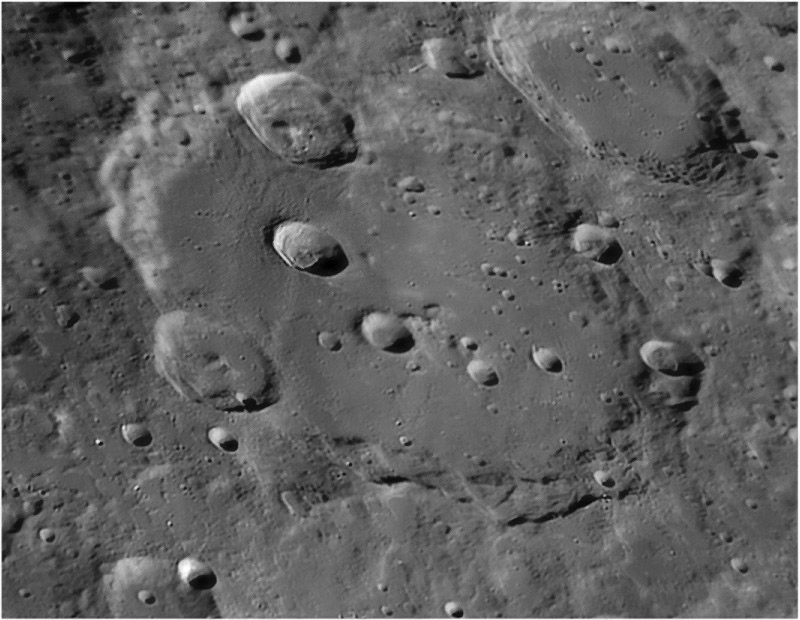Difference between revisions of "October 12, 2009"
| Line 3: | Line 3: | ||
<!-- ws:start:WikiTextHeadingRule:0:<h1> --> | <!-- ws:start:WikiTextHeadingRule:0:<h1> --> | ||
<!-- ws:start:WikiTextLocalImageRule:6:<img src="/file/view/LPOD-Oct12b-09.jpg/94507956/LPOD-Oct12b-09.jpg" alt="" title="" /> -->[[File:LPOD-Oct12b-09.jpg|LPOD-Oct12b-09.jpg]]<!-- ws:end:WikiTextLocalImageRule:6 --><br /> | <!-- ws:start:WikiTextLocalImageRule:6:<img src="/file/view/LPOD-Oct12b-09.jpg/94507956/LPOD-Oct12b-09.jpg" alt="" title="" /> -->[[File:LPOD-Oct12b-09.jpg|LPOD-Oct12b-09.jpg]]<!-- ws:end:WikiTextLocalImageRule:6 --><br /> | ||
| − | <em>south up image by [mailto:MICKHYDE@GMAIL.COM | + | <em>south up image by [mailto:MICKHYDE@GMAIL.COM Mick Hyde]</em><br /> |
<br /> | <br /> | ||
Most projectiles don't hit flat plains, but instead smash into pre-existing craters and mountains. One of the most extreme variations of elevations for an impact is the rim of a big and deep crater. Clavius, at 5 km deep, has a wide rim that records at least two craters that had the misfortune of hitting it. Porter and Rutherfurd are both relatively young complex craters (both with diameter of 51 km) with one part of their rim near the top of Clavius' rim and the other side nearly on Clavius' floor. Porter - at bottom left on this south up view - has a wide, slump-filled southern wall, whereas the wall near the floor of Clavius is narrow, low and devoid of slumped material. Rutherfurd is similar, with a wide mass of material that slide down from the high southern wall; its floor and central peak also appear to be displaced toward the Clavius side. I am sure that when elevations become available that both of these craters will have tilted rims. A smaller example of a tilted crater is Clavius L, cutting the far right of Clavius' rim. This crater has a wide and high wall to the right and a much lower and narrower wall on the low side. The material that slid down the right wall has piled into a jumble covering the floor. Can you find more tilted craters on other parts of the Moon?<br /> | Most projectiles don't hit flat plains, but instead smash into pre-existing craters and mountains. One of the most extreme variations of elevations for an impact is the rim of a big and deep crater. Clavius, at 5 km deep, has a wide rim that records at least two craters that had the misfortune of hitting it. Porter and Rutherfurd are both relatively young complex craters (both with diameter of 51 km) with one part of their rim near the top of Clavius' rim and the other side nearly on Clavius' floor. Porter - at bottom left on this south up view - has a wide, slump-filled southern wall, whereas the wall near the floor of Clavius is narrow, low and devoid of slumped material. Rutherfurd is similar, with a wide mass of material that slide down from the high southern wall; its floor and central peak also appear to be displaced toward the Clavius side. I am sure that when elevations become available that both of these craters will have tilted rims. A smaller example of a tilted crater is Clavius L, cutting the far right of Clavius' rim. This crater has a wide and high wall to the right and a much lower and narrower wall on the low side. The material that slid down the right wall has piled into a jumble covering the floor. Can you find more tilted craters on other parts of the Moon?<br /> | ||
<br /> | <br /> | ||
| − | <em>[mailto:tychocrater@yahoo.com | + | <em>[mailto:tychocrater@yahoo.com Chuck Wood]</em><br /> |
<br /> | <br /> | ||
<strong>Technical Details</strong><br /> | <strong>Technical Details</strong><br /> | ||
| − | 09/02/07. C9.25 + 3x TV Barlow + DMK CCD Camera. Today's [http://lpod.org/coppermine/displayimage.php?pos=-2367 | + | 09/02/07. C9.25 + 3x TV Barlow + DMK CCD Camera. Today's [http://lpod.org/coppermine/displayimage.php?pos=-2367 image] was found on the LPOD Photo Gallery.<br /> |
<br /> | <br /> | ||
<strong>Related Links</strong><br /> | <strong>Related Links</strong><br /> | ||
Rükl plate [http://the-moon.wikispaces.com/R%C3%BCkl+72 72]<br /> | Rükl plate [http://the-moon.wikispaces.com/R%C3%BCkl+72 72]<br /> | ||
| − | AstroMick [http://astromick.blogspot.com/ | + | AstroMick [http://astromick.blogspot.com/ webpage]<br /> |
<br /> | <br /> | ||
<hr /> | <hr /> | ||
Revision as of 19:03, 17 January 2015
Tilted Craters

south up image by Mick Hyde
Most projectiles don't hit flat plains, but instead smash into pre-existing craters and mountains. One of the most extreme variations of elevations for an impact is the rim of a big and deep crater. Clavius, at 5 km deep, has a wide rim that records at least two craters that had the misfortune of hitting it. Porter and Rutherfurd are both relatively young complex craters (both with diameter of 51 km) with one part of their rim near the top of Clavius' rim and the other side nearly on Clavius' floor. Porter - at bottom left on this south up view - has a wide, slump-filled southern wall, whereas the wall near the floor of Clavius is narrow, low and devoid of slumped material. Rutherfurd is similar, with a wide mass of material that slide down from the high southern wall; its floor and central peak also appear to be displaced toward the Clavius side. I am sure that when elevations become available that both of these craters will have tilted rims. A smaller example of a tilted crater is Clavius L, cutting the far right of Clavius' rim. This crater has a wide and high wall to the right and a much lower and narrower wall on the low side. The material that slid down the right wall has piled into a jumble covering the floor. Can you find more tilted craters on other parts of the Moon?
Chuck Wood
Technical Details
09/02/07. C9.25 + 3x TV Barlow + DMK CCD Camera. Today's image was found on the LPOD Photo Gallery.
Related Links
Rükl plate 72
AstroMick webpage



